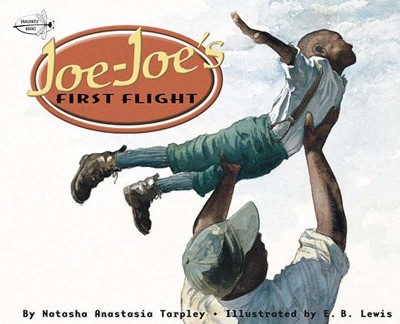Year Published: 2008
Written by: Natasha Tarpley
Illustrated by: E.B. Lewis
Description
Joe-Joe’s father works at the local airport, one of the first in the area, at a time when segregation rules. Even though the men who work at the airport, including Joe-Joe’s dad, were promised flying jobs, the owner refuses to let them fly. The town of Blind Eye has lost hope over the men’s heartbreak and the injustice being done to them, so much so that the moon won’t shine down on it any longer. More than anything, Joe-Joe wants to bring the moon back to Blind Eye so he can return hope to the townspeople. This is an extraordinary storybook about lost hope and what can happen when dreams are allowed to flourish.
From School Library Journal
Grade 2-4-Ever since planes began to take off from the little airport in the town of Blind Eye in 1922, Joe-Joe’s father has yearned to fly and he inflames his son with that same longing. But despite promises from his boss at the airport, it’s obvious that African Americans will not be allowed to take to the air any time soon. Such a pall covers the town because of this injustice that even the Moon remains hidden: “All that lost hope formed a cloud over the town, and now even the moonlight and the stars can’t break through.” In his imagination, Joe-Joe climbs aboard a plane, flies to the Moon, and brings it home to the cheers of the townsfolk below. Lewis’s large watercolor paintings capture the flavor of this period-caps, knickers, cars, flying helmet, and goggles-and the early planes. From a beginning quote by Virginia Hamilton, “They say the people could fly-” to the endnote in which Tarpley elaborates on African Americans’ struggle for the right to fly, this is a celebration of the human spirit and the courage and determination of a people to soar. Louise Borden and Mary Kay Kroeger’s Fly High: The Story of Bessie Coleman (McElderry, 2001)
From Booklist
PreS-Gr. 2. In the 1920s, in a town called Blind Eye, a boy named Joe-Joe dreams about flying. His father works at the town’s airport, but like the other African American workers, he hasn’t been allowed to fly planes. The town’s hopelessness hangs so heavily that “even the moonlight and stars can’t get through.” One evening Joe-Joe goes to the airport with his father, and as he curls up in a plane’s cockpit, he dreams of soaring off the runway and coaxing the moon to follow him home. Children may have difficulty determining where Joe-Joe’s dream begins and ends, but Tarpley’s warm, colloquial words and Lewis’ exquisite watercolors capture the joy and sense of empowerment in the boy’s fantasy as well as the tenderness between father and son. Children who share Joe-Joe’s dream will also love Lewis’ detailed images of the antique planes. An afterword gives some history of African American aviation.-Gillian Engberg












